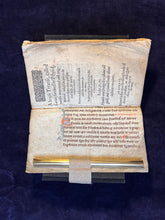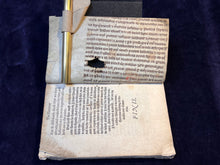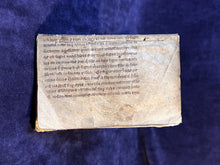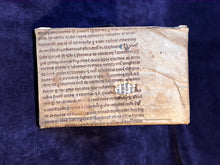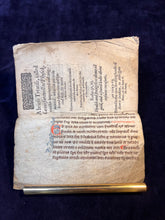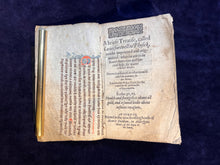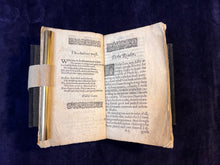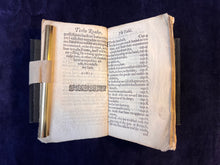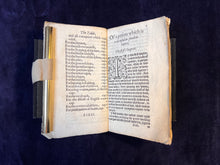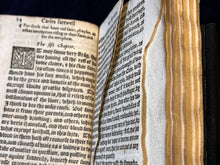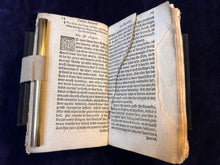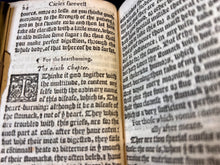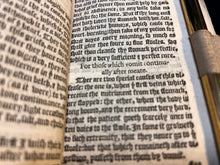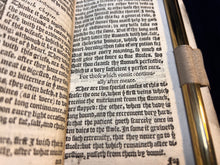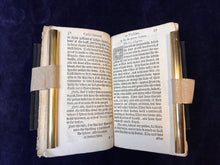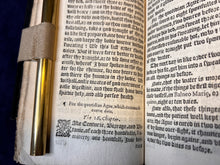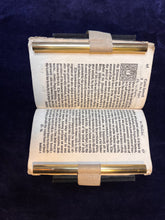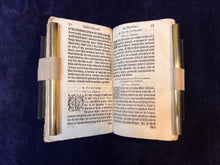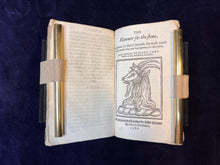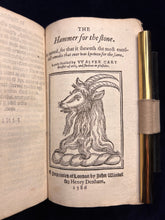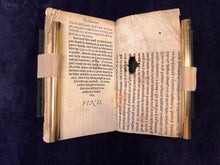
In the 9th century, the Persian scholar Al-Farghani wrote his Elements of Astronomy on the Celestian Motions (or, Astronomia differentia, also titled Alfragani Elementa Astronomica, because of the lack of authority titles in the pre-Modern period). In part a summary of Ptolomy’s Greek Almagest, and in part a scientific tour de force in its own right, the Elements of Astronomy presented a (correct) calculation of the circumference of the earth and the tilt of the Earth’s axis. In the 12th century, this Arabic text was translated into Latin, first by John of Seville, then by Gerard of Cremona. The Latin text puts to bed the tired fallacy that particularly Medieval peoples believed the Earth was flat. On this leaf the last line reads: Dicamusque cum puncto sphere terre esset punctus sphere celi necesse fuit ut superficies circuli equinoctii diei divideret superam terre… [And let us say that when the point of the sphere of the earth be the point of the sphere of the sky, it is necessary that the surface of the equinoctial circle should divide the upper part of the earth…] The content of this section of text deals with the equinoxes and solstices, with “erratic planets”, with the astrological names for the 12 parts of the sky (Capricorn, Aries, and Taurus are named in particular), and with the shockingly accurate calculation of the tilt of the Earth’s axis at 23 degrees and 34 minutes.
English features, such as the wedged ascenders on the letters l and b couple with spiky letters g, to place us in the English countryside right as Oxford is about to explode with scholarship in the thirteenth century. The hand is a clear, early Gothic, which is starting to fuse convex curves and has almost entirely adopted the round s. The scribe uses abbreviations but not to the detriment of legibility. The margins are wide, even in its current state, allowing for notes which were never taken.
The text that Dante used to write of Beatrice that which has never been written of any other woman and to model his concept of the earthly and heavenly spheres.
The text that provided Christopher Columbus the calculations to believe he could make it around the world.
This is that text.
It has been over 40 years since the last recognised Alfraganus text from this time period was offered on auction.
About the Manuscript:
[Likely Oxford, England, 1st half of the 13th century] Single partial leaf of Al-Farghani/Alfraganus’ Astronomi differentia (also titled: Alfragani Elementa Astronomica) Chapter V, used as limp vellum binding for 16th century treatise on medicine. (145 x 190mm). Approx. 29 lines, in early Gothic script, with one 2-line initial in red with blue pen-flourishes; one rubricated line filler; red and blue pilcrows. Abbreviations used but still quite legible. Likely originally two columns, bottom foredge-side remains, with ruling still visible. A flaw in the parchment obscures several words. Crossed tironian ets, wedged ascenders, sharp g (bottom bowl occasionally flattened), 2-shaped r, two compartment a (not always closed), some (but not consistent) fusion of convex curves, slash over i, primarily round s with occasional terminal long s, tongued e, round and slated d, single uncial T.
Arabic to Latin translations attributed to John of Seville (ca. 1135 or 1142) and Gerard of Cremona (before 1175), both Toledo-based translators. This leaf seems to follow the John of Seville translation.
About the Book:
CARY, Walter A briefe Treatise, called Caries farewell to Physick, newlie imprinted and augmented : wherein are to be found diverse and speciall helps for manie ordinarie diseases. Hereunto is adioined an other treatise called the Hammer for the Stone. Published by Walter Carie, for the common vse and benefit of his countrie. At London, Printed in the now dwelling house of Henrie Denham, in Aldersgate street at the signe of the Starre. [First text undated; 1586]
[6], 57, [1]; [24]p. Signatures A-D viii; A vii, B iv. Headlines read “Caries farewell to Physicke.” Bii-Bvi defective, Bvi has a strip torn from the blank fore edge margin which doesn't affect the text and Dv is lacking.
The Hammer has a title page dated 1586 with printer’s device featuring goat’s head, unpaginated and with a separate signature sequence.
This version unrecorded on ESTC.
Carie offers treatments for ailments such as "swimming of the head", "heart-burning", "those who have no appetite to meate", "those who are troubled with the gnawing of the guts of stomach...", both the yellow and black iandesse, "greene sicknes", many times of ague, the plague (of course), the disease of English wanton, and "wormes of all sorts". And let us not forget "those that are troubled with biles, scabs, itches, or suchlike." He could hardly keep his "potion which is to be used in sundrie cures" to himself as he bid a farewell to physicks [being a physician].
Translation:
… Of the first movement because it divides the sphere of the skiy in half. And its length from both axes is a single quantity. Now, the circule of the equinox is called the circle of the day because when the sun passes through it, day and night are equal in the whole earth, as we shall show in what follows. And the second motion which appears to be the son and planets from west to east against the side of the first motion on two other axes coming out of the axes of the first motion, and is called the Greater Circle, the length of which coming out of these axes is of one quantitiy, which is the girdle movement and circle of symbols. And it is the circle described by the sun and its motion from West to East, which is divided in to 12 equal parts which are called signs whose names are Aries, Tauris, &c. Each of these signs is divided by 30 degrees and the whole circle will be 360 degrees and each degree is divided by 60 minutes. It is necessary, therefore, that the circle of the signs should cut off the circle of the equinox day over two points opposite to it, and should deviate from it towards the North or South by the same amount as the point over which the sun passes from South to North from the equinox day…
… It is called the vernal equinox point, which is the begining of the sign of Aries, and the other over which the sun passes from the North to the South is called the Autumnal equinox point, which is the beginning of the sign of Libra. And they become 6 in the septronal signs from the equinox of the day which are from the beginning of the sign of Aries and the end of Virgo and 6 of the meridina signs which are from the beginning of Libra to the end of Pisces. And a third circle is secured in the sky, drawn in latitude from the North, going to the South, on the axes of both circles, and the circle described, or lunate, on the axes of the two circles is named. Cutting off each of the circles of the nest(?)….
By the last declination and longitude from the equinox towards the north and south: and it is named the northern point of the summer solstice, which is the beginning of the sign of Cancer. It is named the meridian or point of the winter soltice, which is the beginning of Capricorn and the arc is that part of the circle which is between the equinoctial line and the solices point of this cricle written on both axes which is between the two point sof the soltices and equinoxes of the day is the amount of deviation of the circle of signs from the equinox of the day. And according to what Ptolemy found, there are 23 degrees. _______ When there was a circle of 360 degrees, and the surest proof by which Almenon proved it, which is interpreted as secure or peaceful or faithful, and many wise men agreed on it that it is 23 degrees and 34 minutes. Let it now be said of what we have said that the erratic planets revolve on their axes…
… The equinoxes of the day are inseparable from their places by the circle described on the axes of both circles. And since, by the grace of God, we have already prefigured what should have been allowed for the movements of both circles, now let us begin to mention the habitable places of earth, according to what we know that has come down to us, and the things that happened in these places about the fickleness of the circle and the difference between night and day. And let us say that when the point of the sphere of the earth was the point of the sphere of the sky, it was necessary that the surface of the circle of the equinoctial day divide the upperm part of the earth by….
Transcription:
[Front back]
… primi motus quia dividit sp(h)eram celi per [medium. Et longitudo]
eius ab utrisque axibus unius quantitas. Nominatur autem circulus
equinoctii diei, quia cum sol transit per eum equantur dies et nox
in universa terra que quemadmodus ostendemus in sequentibus. Et motus
secundus qui videtur esse soli et planetis ab occidente in orientem contra
partem primi motus super duos alios axes exeuntes ab axibus
motus primi et nominatur circulus maior, cuius longitudo
ab hiis axibus exeuntibus est unius quantitatis, qui est cingulus
motus et circulus signorum. et ipse est circulus quem desc-
-ribit sol per motum suum ab occidente in orientem , qui divi-
-ditur per 12 partes equales [que nominantur signa, quorum]
nomina sunt Aries , Taurus, &c. Unisquis [istorum signorum] divid-
-Itur per 30 gradus eritque universitas circuli 360 gradum
Et unusquisque gradus dividitur per .60. minuta. Necesse est ergo
ut abscindat circulus signorum circulum equinoctii diei super
duos punctos sibi oppositos et declinet ab eo versus septem-
[spine]
-trionem vel meridiem una quantitate et punctus super quem
transit sol a meridie ad septentrionem ab equinoctio diei
[Front Front]
nominatur punctus equinoctialis vernalis quod est inicium signi
arietis et alter super quem transit sol a setemtrionale in
merediem appellatur punctus equinoccialem autumnalis
quod est signi inicium signi libre. Fiuntque .6. signa septriona-
-lia ab equinoccio diei que sunt ab inicio signi arietis usque
in finem virginis et .6. signa merediana que sunt ab inicio
libres usque in finem piscis. Et siguratur in celo circ-
-ulus tercius in latitudinem ductus a septemtrione .I. in meri-
-diem vadens super axes utrorumque circulorum nominaturque cir-
-Culus descriptus vel luneatus super axes virorumque circulo-
-rum. Abscindens unumquodque circulorum circulum nidelum(?) equi—
[Inside back]
Ultima declinatione & longitudine ab equinoctio diei vers-
-us septenmtrionem & meridiem: nominaturque punctus septem-
-trionalis solsticii estiualis qui est inicium signi cancri. Mere-
-dianus aut punctus nominatur solsticii hyemalis qui est
inicium capricorni. & arcus id est pars circuli qui est inter lineam
equinoctialem & punctum Solsticialem huius circuli descripti super
utrosque axes qui est inter utrosque punctos solsticiorum & equin-
-octium diei est quantitas declinationis circuli signorum ab equi-
-noctio diei. Et est secundum quod inuenit Tholomeus 23 graduum.
_________ cum fuit circulus 360 graduum proba-
-tione autem certissima qua probauit Almenon [Almeon] qui interpretatur secur-
-us vel pacificus siue fidelisi & conuenerunt in ea plures sapientes
quod est 23 graduum & 34 minutorum. Iam patiut de hoc quod
diximus quod planete erratici voluunutur super axes ciriculi....
[Inside front]
equinoctii diei inseperabiles a locis suis a circulo desc-
-ripto super axes utrorumque circulorum.
Et quia deo axuliante iam premisimus quod debuit
permitti de utriusque motibus circuli. Nunc incipiamus comme-
-morare loca terre habitabilia secundum quod novimus ey perve-
-nit ad nos et universa que accidunt hiis locuis de volubi-
-litate circuli et diversitate noctis atque diei. Dicamusque
cum puncto spere terre esset punctus spere celi necesse fuit ut
superficies circuli equinoctii diei divideret superam terre per…
MB358





















